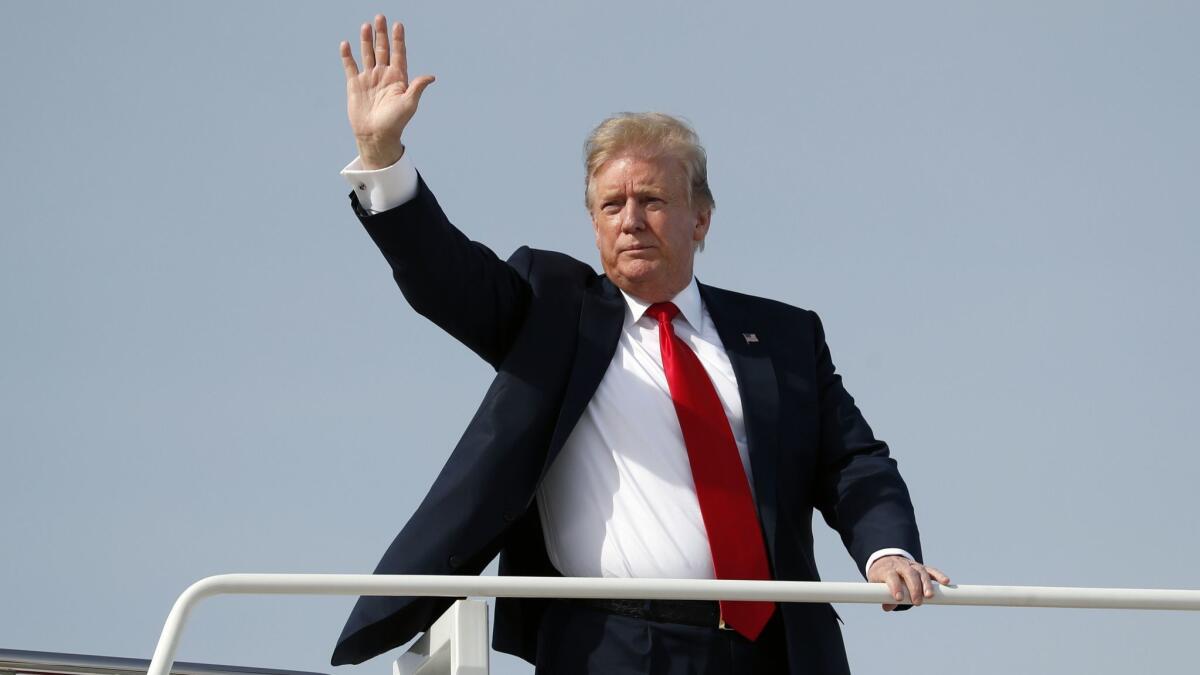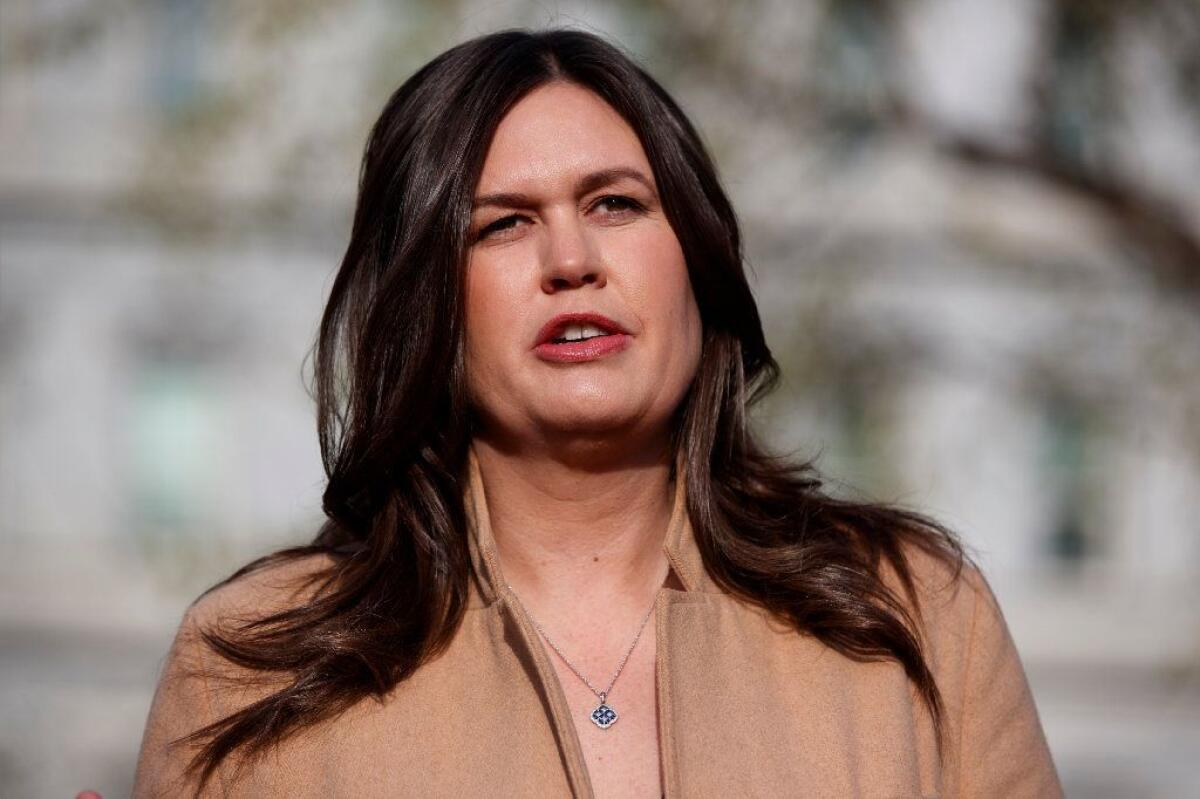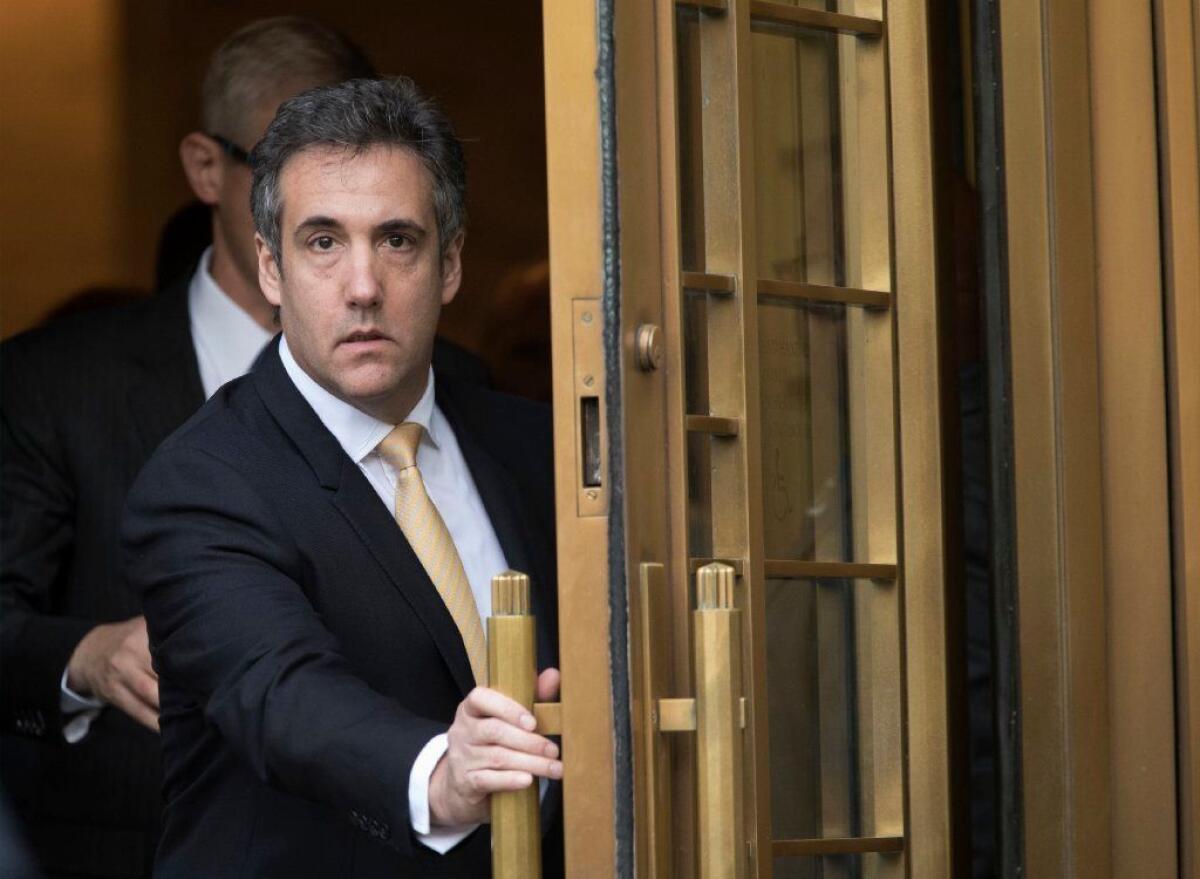Mueller report exposes all the president’s liars

- Share via
Reporting from Washington — Addressing reporters from the White House lectern, then-Deputy Press Secretary Sarah Huckabee Sanders made a startling claim shortly after President Trump fired FBI Director James B. Comey two years ago.
“I’ve heard from countless members of the FBI that are grateful and thankful for the president’s decision,” she said, refusing to back down when pressed on the issue. “Between emails, text messages, absolutely,” she insisted.
It wasn’t true. She later told prosecutors working for special counsel Robert S. Mueller III that her comments were a “slip of the tongue.”
It’s a crime to lie to federal investigators or Congress, a lesson that many of Trump’s associates found out the hard way. (Just ask former national security advisor Michael Flynn or disbarred lawyer Michael Cohen; they’re among several who pleaded guilty.) But it’s not a crime to lie to reporters and the American people, and for that the president’s team can be grateful.
The redacted 448-page Mueller report, released Thursday, exposed in voluminous detail how the Trump White House is comfortable not only spinning the truth, but outright demolishing it.
Sometimes the president did the lying himself. Sometimes he had others lie for him. And sometimes people lied because they thought it was required of them.
Sanders refused to back down Friday when questioned on ABC News. She insisted that she had misspoken about “countless” FBI agents “in the heat of the moment,” even though she repeated the claim multiple times.
“It wasn’t a scripted talking point,” she scoffed. “I’m sorry I wasn’t a robot like the Democrat Party.”

Not everyone around Trump has been willing to lie on his behalf.
After a March 22, 2017, Oval Office meeting, the president asked Director of National Intelligence Dan Coats to say publicly that Trump didn’t have any links to Russia, the report said. The claim would have been false, since Trump sought to build a luxury skyscraper in Moscow while running for president.
Coats declined, telling Trump “it was not his role to make a public statement on the Russia investigation,” according to the report.
Others also pushed back. When Trump fired Comey on May 9, 2017, he asked Deputy Atty. Gen. Rod Rosenstein to hold a news conference.
“Rosenstein responded that this was not a good idea because if the press asked him, he would tell the truth that Comey’s firing was not his idea,” the report said.
But the report showed numerous others were willing to spread falsehoods on Trump’s behalf.
After the president fired Comey, the White House issued a statement saying that Trump had acted on a recommendation from the Justice Department. But Trump had previously decided to sack Comey. Reince Priebus, then chief of staff, told investigators he believed the president personally dictated the misleading statement recommending the firing.
Days later, when Mueller was appointed special counsel, White House officials told reporters that Trump was undisturbed by the development. In fact, he was devastated.
“This is terrible. This is the end of my presidency,” he said, according to notes taken by an aide.
Trump sometimes lied to his own aides. One episode involved a resignation letter prepared by Jeff Sessions, then the attorney general, who had infuriated Trump by recusing himself from supervising the Russia investigation.
The president decided not to push out Sessions at the time, but he took the letter with him on a trip to the Middle East, showing it to senior advisors aboard Air Force One.
Priebus was concerned that the president planned to use the letter as leverage over Sessions, and he asked about it during the trip. Trump falsely said the document was back in his White House residence.
Later that year, Trump tried to prevent the truth from coming out about senior campaign officials’ June 9, 2016, meeting at Trump Tower with a Kremlin-connected lawyer.
Hope Hicks, then White House communications director, recalled telling Trump that emails setting up the meeting looked “really bad.”
The messages showed that the president’s eldest son, Donald Trump Jr., was told the lawyer was working on behalf of the Russian government and would bring damaging information on Hillary Clinton. Trump Jr. had emailed back, “If it’s what you say I love it.”
The president “directed aides not to publicly disclose the emails,” the report said.
When the meeting was revealed by the New York Times on July 8, 2017, Trump edited a public statement to conceal crucial details. He removed a line admitting the meeting involved someone who “might have information helpful to the campaign,” and he claimed that participants talked about the adoption of Russian children. The statement was issued under Trump Jr.’s name.
The embarrassing emails soon leaked, contradicting the statement dictated by the president, but the lies continued.
“Over the next several days, the president’s personal counsel repeatedly and inaccurately denied that the president played any role in drafting Trump Jr.’s statement,” the report said.
Once the president’s role was revealed, he downplayed the importance of being honest with the public.
“It’s a statement to the New York Times.... That’s not a statement to a high tribunal of judges,” Trump told reporters.
Pervasive lying is an unsurprising result of having a president whose dishonesty has been a hallmark for years, whether it’s exaggerating the height of his buildings or claiming that President Obama wasn’t born in the United States.
While every administration is accused of dissembling or worse at times, the report makes clear that Trump leads a White House where falsehoods and misrepresentations are common practice.
When a Washington Post columnist reported on Jan. 9, 2017, that Flynn may have discussed sanctions with the Russian ambassador during the presidential transition — contradicting what Flynn had told other administration officials — Trump was furious.
“What the hell is this all about?” Trump asked Priebus, who told Flynn that Trump was unhappy. Flynn then asked his deputy, K.T. McFarland, to help “kill the story,” the report said.
McFarland called the columnist and denied that Flynn and the Russian ambassador had talked about sanctions, even though she “knew she was providing false information,” according to the report.
Flynn was forced out of the administration about three weeks after Trump’s inauguration. He has pleaded guilty to lying to federal agents, and he’s awaiting sentencing as he cooperates with another investigation involving his business associates and undisclosed Turkish lobbying.

Mueller’s report includes new details on how Cohen prepared his false congressional testimony about plans for a Trump Tower in Moscow.
During those months in 2017, Cohen was in a joint defense agreement with Trump, and he discussed his upcoming testimony with the president’s legal team. Cohen said the lawyer, who was not named, told him “the president loves you” and would have his back if he stayed on message. Unless Cohen “went rogue,” he would be protected, according to the report.
A draft of Cohen’s testimony was circulated among members of the joint defense agreement, and a key line about “limited contacts with Russian government officials” was deleted. Cohen had, in fact, spoken with a Kremlin office about the proposal.
The testimony also included the falsehood that work on the proposal ended in January 2016 rather than several months later, after Trump had secured the Republican presidential nomination.
Cohen told prosecutors he wanted to adhere to the “party line” by downplaying Trump’s ties to Russia, according to the report. He’s been sentenced to three years in prison for lying to Congress and several other crimes, and he’s scheduled to report to prison on May 6.
But Cohen didn’t just lie to lawmakers. Months beforehand, he misled a New York Times reporter about the Moscow project negotiations, the report said. He told the special counsel’s office the lies were intended “to dismiss the idea of a substantial connection between Trump and Russia.”
They were part of a “script,” Cohen told prosecutors, that he developed with others — including the president himself.
More to Read
Get the L.A. Times Politics newsletter
Deeply reported insights into legislation, politics and policy from Sacramento, Washington and beyond. In your inbox twice per week.
You may occasionally receive promotional content from the Los Angeles Times.











